How To Pick A Lock Without a Key? Expert Step by Step Guide
There are various ways to unlock a door without a key. You can pick the lock with lock picks, bobby pins, and paper clips. You can bump or shim the lock.
There are various ways to unlock a door without a key. You can pick the lock with lock picks, bobby pins, and paper clips. You can bump or shim the lock.
We’ve all been locked out a time or two—for the married folk, maybe more. But worse than being locked out is not having a crafty way to get back in.
There are various ways to unlock a door without a key. You can pick the lock with lock picks, bobby pins, and paper clips. You can bump or shim the lock. And for the uninspired, you can even resort to brute force and kick in the door or drill the lock.
This guide will examine standard and effective methods to open a locked door without a key.
To understand the goal of lock picking, we need to see what components a pin tumbler lock has and how all these pieces work together.
A pin tumbler lock has six primary components:
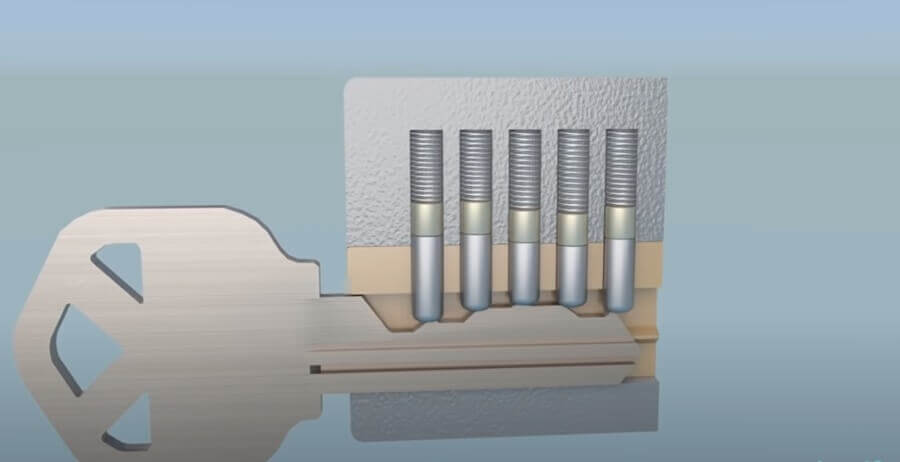
Below is an animation of a key inserted into a pin tumbler lock. To learn more about the key, check out my guide, “Parts of a Key and How They Work.”
As we can see, when the key is inserted into the plug, it raises the pins to a specific location where the driver pins are no longer obstructing the shear line.
We must raise these pins to the same height as a key to pick a lock.
Our first method of unlocking a door without a key is the infamous craft of lock picking.
Don’t worry; lock picking is easy to learn and apply, and I’ll cover the basics in this guide. If you want a deeper dive into lock picking, consider checking out my Ultimate Lock Picking Guide.
Lock-picking is best accomplished using lock-picking tools, and contrary to what most people think, lock-picking is not illegal in most places. However, if you’re in a pinch, you can sometimes get away with improvised tools such as bobby pins and paperclips.
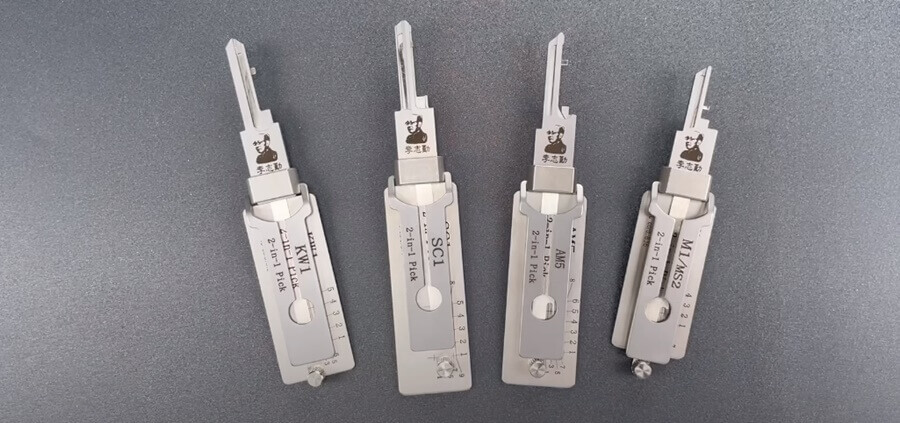
Please note: Lock-picking tools are usually used for unlocking a pin tumbler lock. The lock-picking tools may not be right for the deadbolt and mortise locks.
So let’s move on and look at three quick and dirty ways to pick a lock: a lock pick, a paperclip, and a bobby pin.
Accurate lock picks are ideal if you’re not in a pinch and have the time to buy some lock-picking tools or know someone with a set.
They will consistently outperform improvised tools, and not all locks can be opened using bobby pins and paperclips. Some keyways are too small, and some locks include extra security features that can’t be bypassed without proper tools.
If you’ve got time to spare, consider picking up a lock pick set for emergencies. I recommend the Peterson GSP Ghost lock pick set. It’s beginner-friendly and has an excellent selection of tools that can bypass nearly any pin tumbler lock that stands in your way.
If you want something more discrete, you can also snag a lock pick card that fits in your wallet and has all the tools you need to pick essential locks. I recently posted a review on the best wallet lock pick cards for everyday carry.
Picking a lock requires a lock pick and a tension wrench.
The lock pick will be used to lift pins to the correct height. There are many different types of lock picks. However, we’ll focus on using a rake—the most beginner-friendly and easiest lock pick. Below are examples of two very common rakes.
The tension wrench acts similarly to the key. We use it to apply a rotational force to the plug, which binds the pins and turns the plug after we pick the lock.
Once you have your tools, you’re ready to start picking.
Note: If the lock doesn’t open within 10 seconds of scrubbing, release the tension on the plug to reset the pins and attempt steps 1 – 3 again. Also, try adjusting the pressure you put on your tension wrench. When raking, less is typically better.
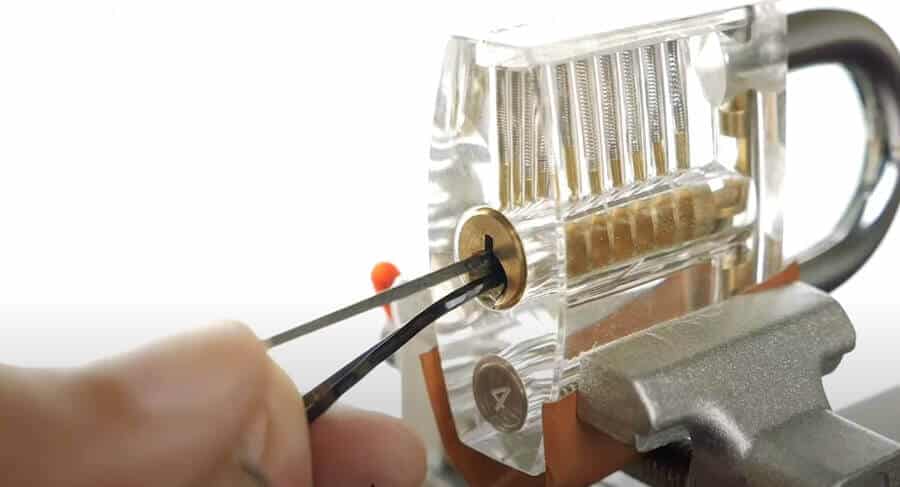
While picking locks with bobby pins may sound like movie magic, they’re a viable option against essential locks.
They don’t work well on locks with tiny or paracentric keyways. But, if you’re dealing with a wide-open keyway, this method may work for you.
It would be best if you had two tools, a lock pick and a tension wrench, to pick a lock with a bobby pin. I briefly covered both tools in the section above (click here to scroll up and review that).
You can find the step-by-step directions to bending the tools in my guide to bobby pin lock picking if you want to use bobby pins.
Once you’ve bent your bobby pin lock-picking tools.
Note: If the lock doesn’t open within 10 seconds of scrubbing, release the tension on the plug to reset the pins and attempt steps 1 – 3 again. Also, try adjusting how much tension you put on your tension wrench. When raking, less is typically better.
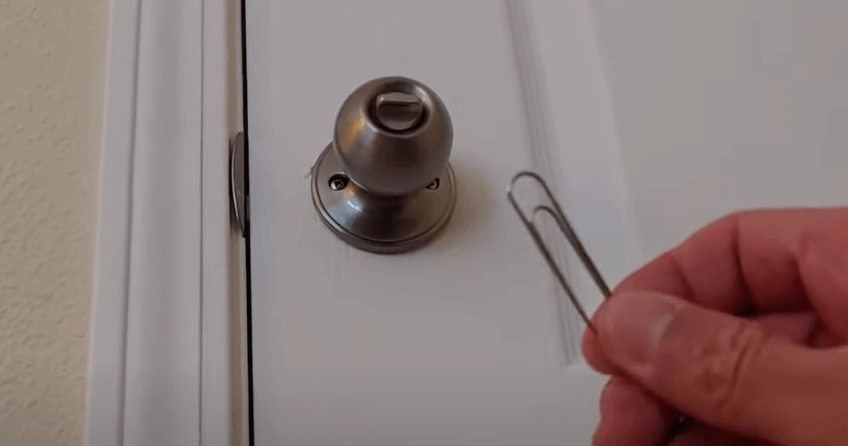
Next is the paperclip; they are pretty handy for picking essential locks. However, like the bobby pin, they struggle with tighter keyways and radical warding.
You need two tools to pick a lock with paper clips, a lock pick, and a tension wrench. I briefly covered both tools in the section above (click here to scroll up and review that).
In my paperclip lock-picking guide, you can find my step-by-step directions for bending your paperclip lock-picking tools.
To pick a lock with a paperclip, follow the steps below.
Note: If the lock doesn’t open within 10 seconds of scrubbing, release the tension on the plug to reset the pins and attempt steps 1 – 3 again. Also, try adjusting how much tension you put on your tension wrench. When raking, less is typically better.
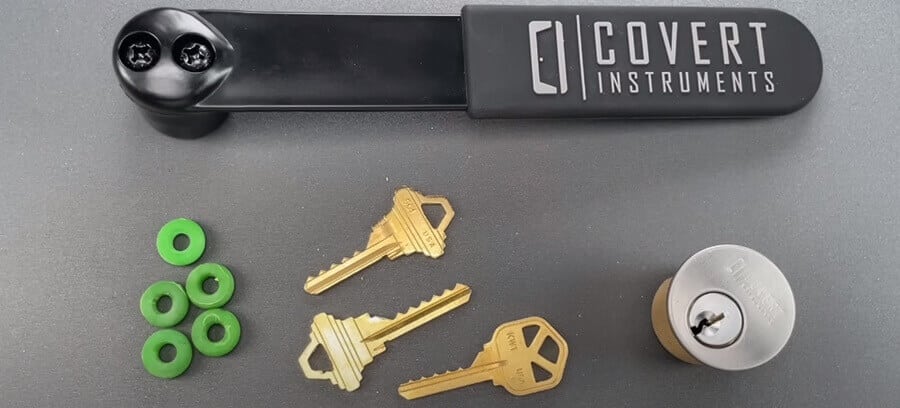
Another way to open a lock without a key is using a technique called lock bumping. Like lock picking, lock bumping requires a unique tool called a “bump key” or “999 key.”
But wait, I thought this guide was about opening locks without a key.
Well, the bump key is no ordinary key.
A bump key is a specially crafted key in which all the cuts are cut to the maximum depth of 9. So virtually any new key blank can be turned into a bump key.
Bump keys work by violently bumping pins causing them to jump to their correct positions—the shear line.
This is accomplished by inserting the bump key into the lock, pulling it back out slightly, and, while turning it slightly, hitting it with your hand or a tool such as a bump hammer. Each strike forces the cuts of the key into the pins and throws them upward toward the shear line.
While bump keys can be pretty effective against most pin tumblers, some locks have anti-bump features that can make it difficult, if not impossible, to lock bump.
Bump keys are legal in most locations and can be bought online. They are also lock-specific, meaning you’ll need an identical Kwikset key to bump a Kwikset.
If you would like to learn how to bump locks, be sure to check the following video:
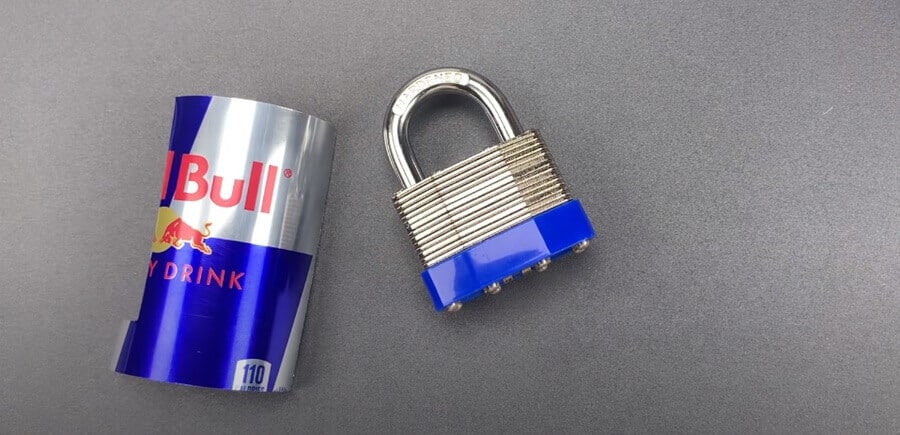
Loiding, also known as “shimming, “is a physical bypass that targets the spring-latch of a door lock using a thin tool such as a credit card, latch slipping tool, or even a knife.
We call the thin tool a “shim” or “loid” and use it to retract the spring latch by slipping it between the door latch and the strike plate.
However, loading requires you to know what direction the slant of the latch is facing.
An easy way to tell is by which side the hinges are on. The slant is facing you if the hinges are not on your side of the door. A drawback of this method is that some locks utilize a deadlatch plunger to prevent loading.
Loiding also does work on doors using a deadbolt.
Now that we understand loiding let’s look at three methods that you can utilize to open a door without a key: Use a credit card, a knife, and Door Latch Shim.
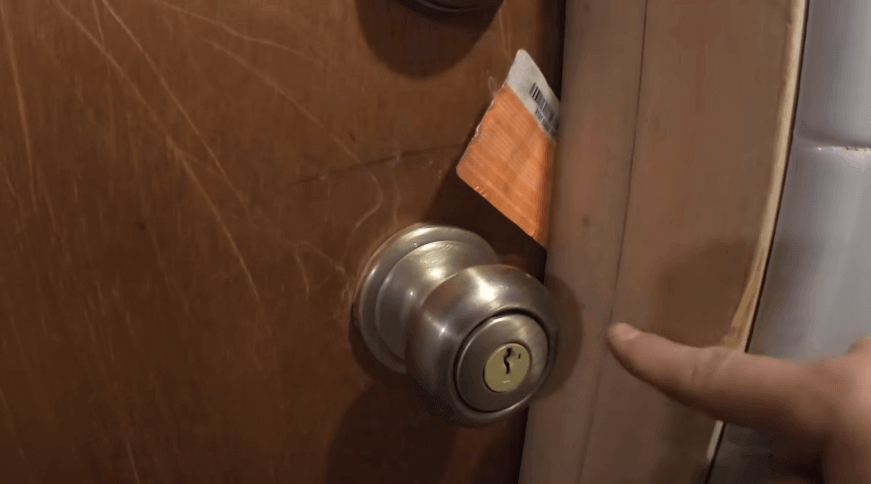
You’ve probably seen it in the movies a million times. Someone pulls out their VISA card and sticks it between the door and frame. They give it a little wiggle and “click! “—the door opens.
A spring bolt lock is one of the most accessible types to pick, and all you will need to do is a credit card. Since this is one of the most accessible types, it is also not particularly secure, so if you have one at home, you should consider replacing it.
However, to use this method, the latch’s slant must be facing the door’s exterior—the hinges should be on the opposite side of the door as you.
There must also be a little wiggle room between the door and the doorframe. Tight trim around the doorframe can make loiding difficult—if not impossible.
To shim a lock with a credit card, wiggle it between the doorframe and the lock until you hit the spring latch. Continue pushing the card into the latch; once it’s fully retracted, the lock will give, and the door will open.
If there is a ton of space between your door and door frame, you may use larger objects such as a butter knife.
Just like the credit card, knives will only work when the slant of the latch is facing you.
To slip a lock using a knife, slide the blade between the doorframe and lock until you feel the latch. Push the blade into the latch until it fully retracts and the door opens.
Credit cards and knives only work on outward-facing latches. What if the latch slant is facing away from you?
In this scenario, you can use a latch-slipping tool. A latch-slipping tool is a thin metal with a hook on the end.
To use a loiding latch tool, insert it between the door above or below the latch. Push the tool through the door seam and slide the hook around the latch.
Next, pull on the tool to retract the spring latch and open the door.
You can buy latch-slipping tools online or easily make them yourself.
A screwdriver can be handy when dealing with an interior door using a privacy lock—those doorknobs with a little hole.
To unlock a privacy lock, you’ll need a flathead screwdriver small enough to fit into the hole on the doorknob.
If your doorknob uses a button lock, you’ll need to push the screwdriver straight into the hole until you hear a click, at which the door will open.
However, if your doorknob uses a thumb-turn, you’ll need to insert the screwdriver into the hole and rotate it until it falls into a slit. Then you’ll turn the screwdriver further until you hear a click.
If you’re unsure which type of lock you have, try both.
Additionally, you can use a screwdriver to remove hinges or shim a doorknob lock if there is enough room between the door and the doorframe.
You’ve got an easy entry if you’re lucky enough to have the hinges on your side of the door.
Most hinges can be removed with a screwdriver and hammer. Once off, the door will swing open from the latch.
Note that the hinges should never be outside any door you rely on for security.
Whether there is a fire behind a locked door or your children lock themselves in their room with your credit card—sometimes you need a door open, and you don’t care what it takes.
If you find yourself in a pinch and don’t mind paying for a new door, doorframe, or lock, you can always resort to destructive means of entry.
There is nothing more classic than kicking down a door.
To kick a door, wind up and aim your kick above, below, or to the side of the lock. The lock is the point of resistance and the weakest part of the door.
Before kicking, consider the material the door is made up of. You may not get far from kicking a stainless steel door.
Also, check the direction in which the door will swing. If the hinges are on the outside, you consider popping the hinges—if you have time.
Also, if it’s not an emergency, consider looking up the pricing for a new door. It may change your mind.
If kicking down a door is not your style, and you want a more subtle and cheaper option, you can always drill the lock.
Sometimes you’ll need to cut your losses and concede. The lock won the day, but the war is far from over.
In these cases, it’s best to call a locksmith, who will essentially attempt many things on this list but with the finesse of a seasoned warrior.
Here are a couple of extra pro tips you might find useful
As we have seen, not all door locks are as safe as we might imagine, so it’s important to consider other ways to keep your home safe. As well as relying on your door lock, consider investing in an alarm system, a security camera, etc.
If you want to learn how to pick locks, the best thing you can do is practice. An excellent way to do this is to buy special practice locks that are clear to allow you to see the pins inside.
First, practice with these locks – they will let you get a feel for what you are doing while also allowing you to see what you are doing.
After this, you can start picking “real” locks that don’t let you see inside.
As we can see, many viable ways to open a lock without using a key exist.
We learned that we could pick the lock, shim the latch, remove the hinges, or even kick down the door.
But this guide only scratched the surface. If you want to learn more about the topics discussed in this guide, consider checking out my Academy, where I publish other free lock-picking and security-based guides.
I hope this “maybe-too-long” guide gave you all the clarity you needed to unlock a door without a key.
Have a wonderful day and happy picking!